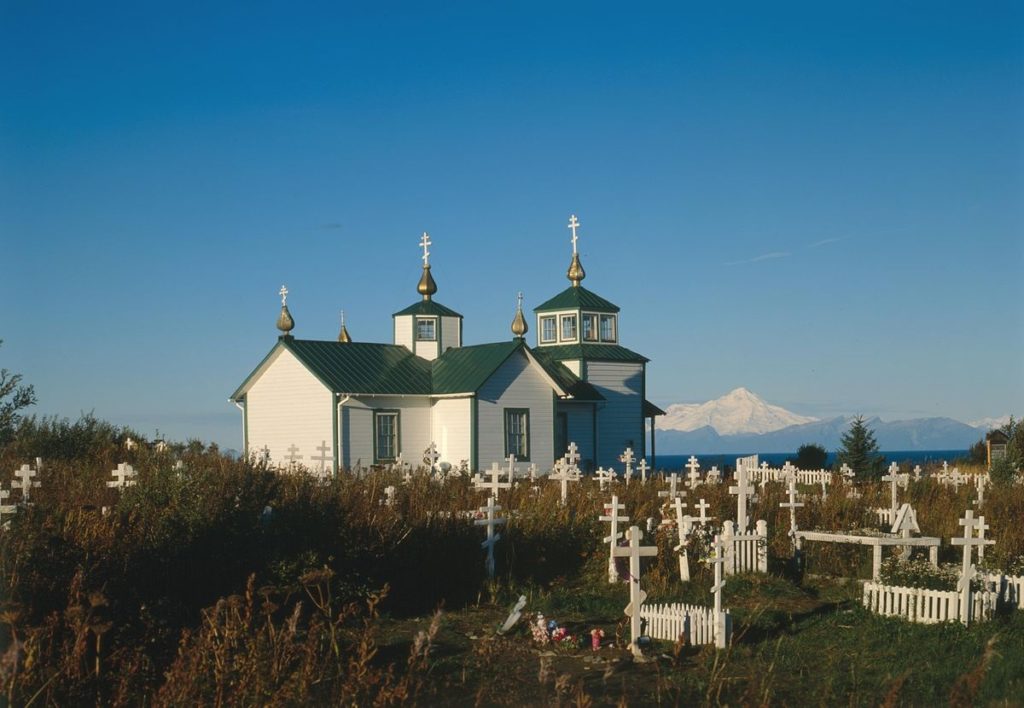Where have all the crops gone? And the cows? A vast stretch of farmland up here in our part of Normandy has been laid waste in the next village, the earth churned up in places and, elsewhere, smoothed out like a pall under the autumn sky.
Pall is the word. The earth will be buried under concrete and tarmac, upsetting not only the water table. Our local farmer Rollon with his handlebar moustache has been expropriated by the local authorities.
He is not the only farmer by a long haul. This concreting, this ‘artificialisation’ of the land is an ongoing trend throughout France.
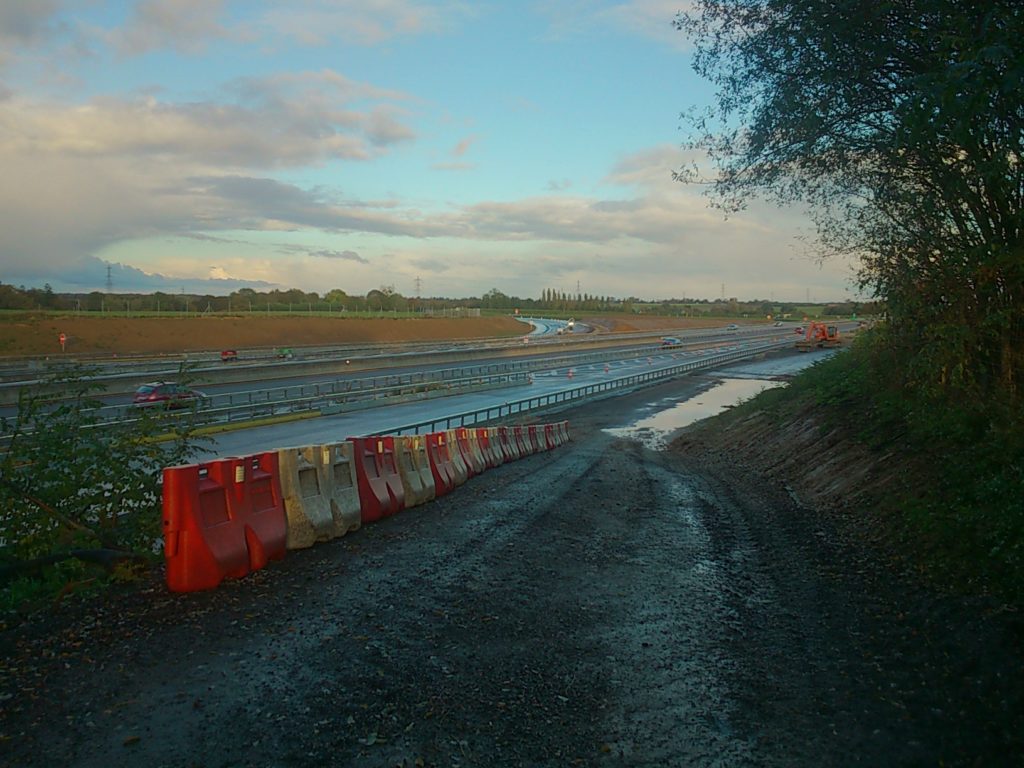
A new motorway exchange – as well as an industrial zone – is being built so that people can get to Caen and come from Caen more easily and quicker, so that the big cities (Rouen, Le Havre, Paris, Caen) can ‘come closer’. This will increase motorway traffic, notably transport trucks using fuel and contributing further to the destruction of the ozone layer. This, coupled with warehouses built either here or elsewhere to stock food for distribution, flies in the face of the Government’s purported intention to reduce food distribution chains, to encourage a local, circular economy, to help farmers and to improve our environment: such was the main thrust of the President’s much publicised General Estates for Food, where discussions had a short-lived moment of euphoria last autumn 2017*.
Policy Contradictions abound
The artificialisation of vast swathes of rich farming land is in blatant disregard of government environmental policy, and specifically snubs the government’s own 2018 Biodiversity Plan, presented last June and calling for ‘zero artificialision’ of the soil (“objectif zero artificialisation”).
Indeed, the government is pressing on with a new bill – when approved it will be called the Loi Elan (élan can be translated as ‘impetus’) – to ‘build more, better and less expensively’, to quote the spokesman during the presentation last April. The government wants to ‘improve legal procedures when dealing with building permits’, in essence: make it more difficult for opposition to such building projects, particularly from environment Associations who are being muzzled by having their budgets cut. While the bill awaits approval, the President is ruling by decree; he published in July an ad hoc Decree to implement the regulatory component of the bill.
It is no wonder the Environment Minister Hulot resigned in exasperation last August. Such construction also contributes to the much reported depletion of the world’s sand used for building material. Architects are in dismay, and some ask why not improve the quality of buildings inside towns, rather than develop suburban areas?
Meanwhile our expropriated Rollon still delivers us our winter firewood and still hunts the wild boar in the woods behind our house (and keeps his gun at the right angle!). We saw him the other day with his trailer carrying the corpulent mass of a formidably tusked victim which no doubt will be shared around the village. But is this his only future activity?
According to government figures, 9.3% of land in metropolitan France is now covered with concrete, tarmac and other ‘artificialised’ surfaces, with the rate growing at 0.8% per year since 2010 (1.4% per year between 2006-2015).
Housing development is increasing at a much faster rate (+9%) than the population (+4%). Do we need so much housing development?
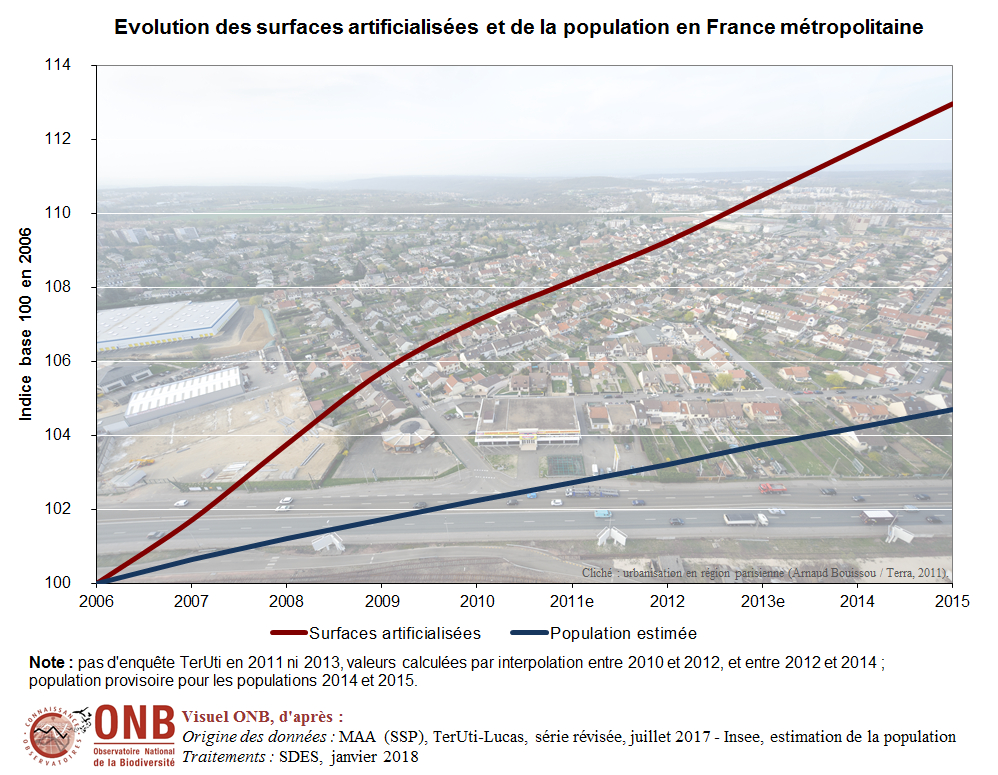
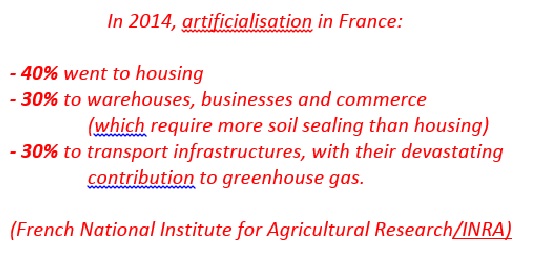
I’ve reported on these pages how the government champions bio farming, new farming technologies such as methanisation to harness farm waste for electricity, soil preservation methods to improve our much needed carbon stocks. Yet it permits big businesses to condemn the very earth we’re supposed to be nurturing. And it threatens the rest of us with fines for not respecting environment regulations.

Statistical confusion
While the black hole between government policies and government action seems to deepen, official statistics are also confusing. I looked up the Government website on soil ‘artificialisation’ which says in a two page document that 9.3% of land in France has been artificialised. It then claims in highlight that European countries have a higher artificialisation rate, pointing out that Germany is at 7.2%, Italy at 7%, and the UK at 6 %. Higher? If France is 9.3%, their sums are blatantly wrong. A two page document should be clear, concise and to the point. It was published December 2016, so they’ve had time to correct it.
What criteria are they using to make such a claim? After reading around, I can only assume they are very confusingly using the Corine Land Cover measure which comes up with the figure of 5.6% (not the government’s 9.3% figure) for France. But they don’t say that. Corine Land Cover is the measure used by the EEC, and does not include surfaces under 25 hectares, wasteland, work sites and artificial green spaces.
The French government uses the Teruti-Lucas method based on statistics. The EU uses the Corine Land Cover method based on remote sensing.
Clear? The French National Institute for Agricultural Research/INRA admitted in 2017 that there is no quantitive measure yet available, but that figures show a general tendency.
Be it mismanagement, or miscommunication, these – and many other – contradictions need to be addressed if the government wants to recover its dwindling popularity.
In the name of jobs?
The local governmental authorities are taking the advantage of this motorway interchange in our next village to build something they call “le développement de sites d’activités prioritaires” ** – translating literally as ‘development of sites with priority activities’. Such an illusive statement gives carte blanche for building practically anything. And the usual mantra is being used: it will create jobs. We shall see, but meanwhile expropriated and well experienced farmers and farm labourers are now out of a job. The job agencies down town advertise many on offer, mostly with no takers. It is to be noted that in a country where enterprises are stifled by strict labour laws, dangling the job carrot is not very convincing. In our village we have a large building complex standing empty for over five years and there are still no takers. There was once a project to use it for a retirement home, but that plan went the way of all flesh, buried in budget issues and legal wrangling.

Le Grand Paris, a serious stifler
Another much vaster artificialisation project in France, amongst many others, is gaining pace in the wheat bowl of France. This area of Paris-Saclay just south of Paris is under the sword of Damocles with the pharaonic Grand Paris Project: 229 square kilometres of the most fertile soil (silt) in France covering 2 Departments (Essone and les Yvelines) is being artificialised. Plans to create an ‘oasis of green’ in this huge area with zones for local agriculture are taken as an affront by local expropriated farmers who dismiss such plans as ‘hot air’ and smoke-and-mirror tactics in the name of galloping urbanisation.
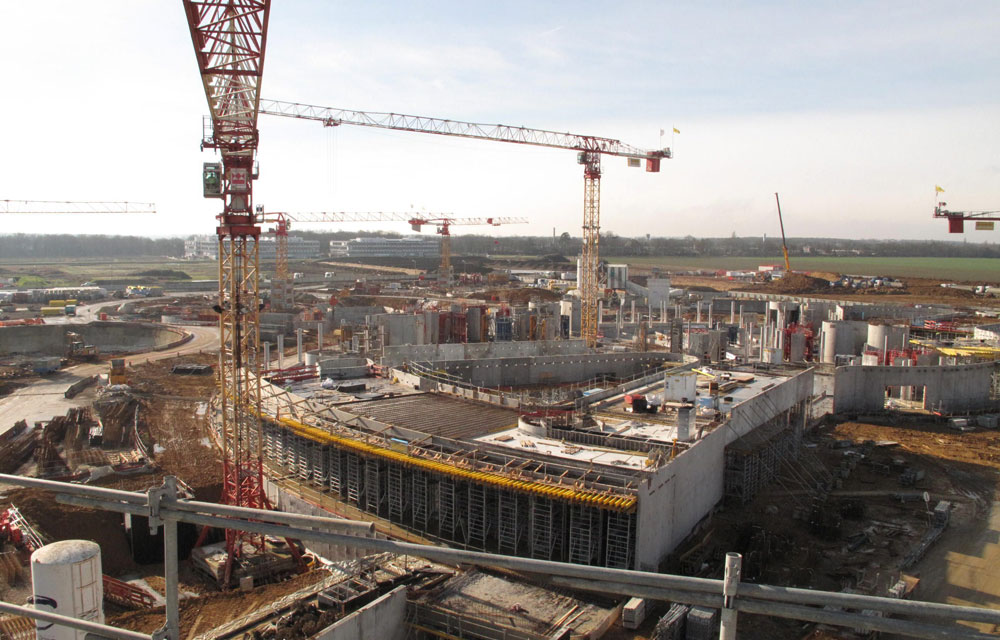

Arguments for and against artificialisation will always be proffered. But perhaps some serious, fundamental questions need to be re-visited. Like other dispossessed farmers, Rollon has been financially compensated to stop producing, but at another kind of price… Dispossessed French farmers abound, with distressing personal consequences. The issue of suicide amongst farmers was brought up by the Senate in 2017. The suicide figures are shocking, and often referred to: an official 2016 report shows that a farmer commits suicide every other day***, a rate 20% higher than the rest of the population and that rate is rising – a reflection of how little farmers are considered and appreciated, despite the fact that they are the ones who provide us with the food we eat.
So whenever we seek to get somewhere quicker, whenever you buy food which is not grown locally, it’s good to be aware that there is a certain non-financial price to pay. Such infrastructure developments have serious long-term environmental consequences – and social. Nature, who always has the last word, has shown us tragically in the last few years what man’s interference can bring: catastrophic floods, serious loss of biodiversity, disappearance of species, polluted air and disease…
Here’s to Rollon and his wild boar hunt; he still has a couple of fields left where he grows flax with the those spring flower heads spreading a veil of glorious pastel blue over the land, a much more pleasant and optimistic sight than that pall of condemned earth up by the new motorway exchange.
_______________________________________
*Details of discussions during the Estates General for Food Autumn/Winter 2017 can be found here.
** Click here for report on this local development; see page 5
*** See 2016 official report on farmer suicides published by France’s National Health Agency. One suicide every two days for farmers, particularly those from 45 – 54 years old.
See also:
Mapping soil; increasing carbon stocks.


